|
| |
|
Here you'll find news
articles from the world of antiques.
LATEST NEWS___________________________________________
- See more at: http://theantiquesalmanac.com/antiquesnews.htm#sthash.5I9kaGRu.dpuf
LATEST NEWS___________________________________________ - See
more at: http://theantiquesalmanac.com/antiquesnews.htm#sthash.5I9kaGRu.dpuf
Here you'll find
news articles from the world of antiques.
LATEST NEWS___________________________________________
- See more at: http://theantiquesalmanac.com/antiquesnews.htm#sthash.5I9kaGRu.dpuf
Here you'll find news
articles from the world of antiques.
LATEST NEWS___________________________________________
- See more at: http://theantiquesalmanac.com/antiquesnews.htm#sthash.5I9kaGRu.dpuf
Bruce Museum Offers Exhibit of
Alfred Sisley’s Works
by Bob Brooke
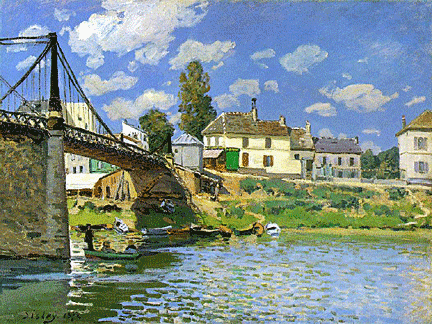 The
works of the Impressionist painters have drawn lots of attention in
the last decade or so. The works of one painter, Alfred Sisley, are
seldom seen together. Those of the Impressionist Movement’s premier
landscape artist are now on view at the Bruce Museum in Greenwich,
Connecticut. The
works of the Impressionist painters have drawn lots of attention in
the last decade or so. The works of one painter, Alfred Sisley, are
seldom seen together. Those of the Impressionist Movement’s premier
landscape artist are now on view at the Bruce Museum in Greenwich,
Connecticut.
The Bruce Museum and the Hôtel de Caumont Centre d’Art in
Aix-en-Provence, France, have mounted a major exhibition of Sisley’s
paintings, the first retrospective in over 20 years of this major
Impressionists. The exhibit, “Alfred Sisley: Impressionist Master,”
spotlights about 50 of Sisley’s paintings, which have come from
private collections and major museums in North America and Europe.
The Bruce Museum is now showing the exhibition until May 21 and is
the only venue in the United States. The show will then travel to
France, where it will be on exhibit from June through October.
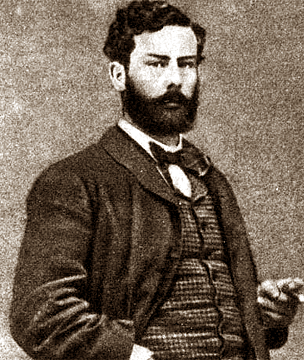 Alfred
Sisley was born in Paris to affluent British parents. His father,
William Sisley, was in the silk business, and his mother Felicia
Sell was a classical music connoisseur. At first, Sisley wanted to
pursue a career in commerce and traveled to London at age 18. From
1857 to 1859, he visited museums, studying both the Old Masters and
the great British landscape painters John Constable and J.M.W.
Turner. On his return to Paris in 1861, he decided to become a
landscape painter and studied at the Paris École des Beaux-Arts
within the atelier of Swiss artist Marc-Charles-Gabriel Gleyre,
where he became acquainted with future Impressionists Claude Monet,
Frédéric Bazille, and Pierre-Auguste Renoir. Alfred
Sisley was born in Paris to affluent British parents. His father,
William Sisley, was in the silk business, and his mother Felicia
Sell was a classical music connoisseur. At first, Sisley wanted to
pursue a career in commerce and traveled to London at age 18. From
1857 to 1859, he visited museums, studying both the Old Masters and
the great British landscape painters John Constable and J.M.W.
Turner. On his return to Paris in 1861, he decided to become a
landscape painter and studied at the Paris École des Beaux-Arts
within the atelier of Swiss artist Marc-Charles-Gabriel Gleyre,
where he became acquainted with future Impressionists Claude Monet,
Frédéric Bazille, and Pierre-Auguste Renoir.
Of all the Impressionist painters, Sisley was the most dedicated to
painting landscapes en plein air, or outdoors, in order to
realistically capture the transient effects of sunlight. This
innovative approach resulted in more broadly painted and colorful
paintings than the public was used to.
The jury of the annual Salon, the most important art exhibition in
France at the time, rejected the works of Sisley and his friends.
And unlike other artists of his time, he painted mostly landscapes
and found the Impressionist style fulfilled his needs as an artist.
After his father’s death, Sisley lived in poverty and never received
the fame or financial rewards from his works during his lifetime.
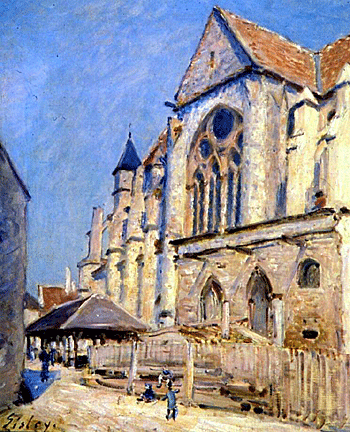 Originally,
Sisley worked in the naturalistic landscape tradition of the
Barbizon School, but increasingly adopted a more Impressionistic
style, recording specific locations in a sequence of paintings done
at different times of the day, weather conditions and seasons. Originally,
Sisley worked in the naturalistic landscape tradition of the
Barbizon School, but increasingly adopted a more Impressionistic
style, recording specific locations in a sequence of paintings done
at different times of the day, weather conditions and seasons.
Until 1880, Sisley lived and worked in the country west of Paris.
Then he and his family moved to a small village near Moret-sur-Loing,
close to the Forest of Fontainebleau, where the painters of the
Barbizon School had worked earlier in the century. Here, the gentle
landscapes with their constantly changing atmosphere were the
perfect match to his talents. Unlike Monet, he never sought the
drama of the rampaging ocean or the brilliantly colored scenery of
the Côte d'Azur.
Sisley was first and foremost a painter of light. He knew how to
make it an integral part of all of his paintings. Among his
important works are a series of paintings of the River Thames,
mostly around Hampton Court, executed in 1874, and landscapes
depicting places in or near Moret-sur-Loing. The notable paintings
of the Seine and its bridges in the former suburbs of Paris are like
many of his landscapes, characterized by tranquillity, in pale
shades of green, pink, purple, dusty blue and cream. Over the years
Sisley's power of expression and color intensity increased.
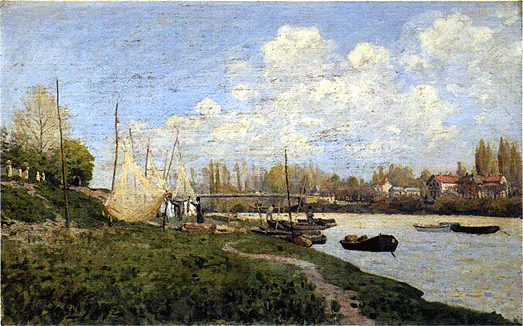
While his landscapes are generally modest in scale and tonally
restrained, the magic with which he was able to capture the effects
of the light dancing on water, the brilliance of winter sun on snow
and hoar frost, the movement of the wind in trees, the exploration
of the depth of a rural scene and the vastness of the skies create
poetic works of art.
The style and subject matter of Camille Pissarro and Edouard Manet
inspired Sisley. But Monet tends to overshadow him among the
Impressionists, even though Sisley’s painting resemble Monet’s in
style and subject matter. His work has lots of atmosphere,
especially through his impressive skies. Sisley's best-known works
are “Street in Moret” and “Sand Heaps,” both owned by the Art
Institute of Chicago, and “The Bridge at Moret-sur-Loing,” shown at
Musée d'Orsay, Paris.
For more information on this unique show, go to the
Bruce Museum’s
Web site.
<
Back to Antiques News Archives
Next Article >
|
|

|
|
FOLLOW MY WEEKLY BLOG
Antiques Q&A
JOIN MY COLLECTION
Antiques and More
on Facebook
LIKE MY FACEBOOK PAGE
The Antiques
Almanac on Facebook |
|
No antiques or collectibles
are sold on this site.
|
|
How to Recognize and
Refinish Antiques for Pleasure and Profit
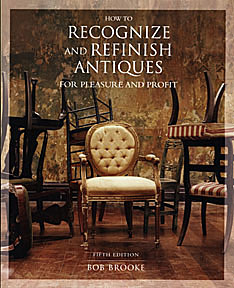
Have
you ever bought an antique or collectible that was less than perfect and
needed some TLC? Bob's new book offers tips and step-by- step
instructions for simple maintenance and restoration of common antiques.
Read an
Excerpt
|
|

|
|
|
|
|
